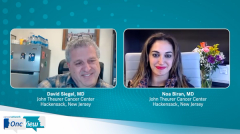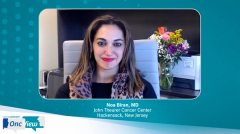
Treatment Sequencing in MM
Experts on multiple myeloma compare their treatment sequencing strategies.
Episodes in this series

Transcript:
David Siegel, MD: We have a lot of really cool tools that we didn’t have a short time ago, and we’re all getting more experienced with them. We’re all gaining insights into the right way to do things and in which patients. These are all important assets.
Noa Biran, MD: Then sequencing, which ones do we use first? Do you have any ideas about that?
David Siegel, MD: I don’t want to start fights because I know that we don’t all agree on these things, and we shouldn’t. My algorithm right now is to try to use a BCMA [B-cell maturation antigen]-directed CAR [chimeric antigen receptor] T-cell [therapy] first, and then use perhaps the non-BCMA–targeting T-cell engagers second. I think those T-cell engagers will evolve more quickly, it’s just easier work to do. The CAR T-cell cellular therapeutics are much more complicated. They’ll get less complicated. So for me at least, CAR T cells first and T-cell engagers second, but that depends on the characteristics of an individual patient. I wouldn’t make that a uniform statement.
Noa Biran, MD: I would agree with you. I think for 3 reasons I would do the CAR T first. No. 1 is, you’re getting more robust apheresis of T cells. Second, you’re giving them a better quality of life for as long as possible in terms of not getting continuous therapy. And I think patients are not getting as many infections at least in the long term with that type of therapy. But certainly, we have retrospective studies that show that these therapies work even when used sequentially. With bispecific T-cell engagers, when you use one and then another, both GPRC5D and then BCMA, and then reverse, we certainly see efficacy and durability. We know that patients who have had bispecific T-cell engagers respond to CAR T, and patients who’ve had CAR T respond to bispecific T-cell engagers.
The one limitation where we initially didn’t see a whole lot of efficacy is in patients who had the BCMA antibody-drug conjugate and then went on to BCMA-directed CAR T. But I’m not sure if that’s going to translate with the bispecific T-cell engagers. It’s great we have all these options. We have all these different combinations. And hopefully, each treatment will continue to increase the lives of our patients by years and decades.
Transcript edited for clarity.
Newsletter
Stay up to date on recent advances in the multidisciplinary approach to cancer.























































































